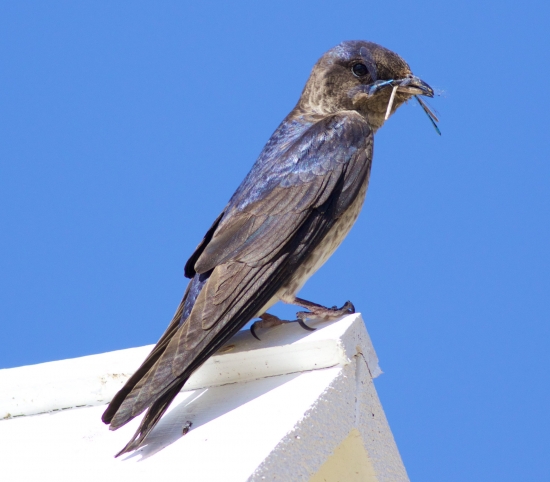Some consider the purple martin "America’s most wanted bird."
Photo by Arlene Koziol
They are also one of our favorite birds! North America's largest swallow is dependent on humans for nesting boxes. Before european settlement, Native Americans set out gourds for purple martins. It's as simple as this: people like martins--and martins like people.
Martins feed high in the sky during the daytime and eat a wide variety of insects including dragonflies, moths, butterflies, flies, beetles, wasps and other flying insects to sustain their growing broods. They can fly a long distance to hunt, and they often seek out hunting grounds over wetlands.
Photo by Arlene Koziol
Sam Robbins wrote in Wisconsin Birdlife 1991 that purple martins were common summer residents especially in eastern Wisconsin. In the first breeding bird atlas (completed in 2000) it was reported that from 1980-2002 there was an 8.4% annual decrease in purple martin numbers in the Breeding Bird Survey. The atlas reported that “many birders in Wisconsin now view Sam’s status as too positive”, thinking that their decline was even steeper than reported.
As resident sanctuary managers at Goose Pond (and with a fitting last name), our special atlas project for this summer is working with volunteers to locate purple martin colonies. Last year we knew of only one colony in Columbia County at Swan Lake near Portage. This year, we found another colony at Swan Lake and 10 Amish families with purple martins nesting at their homes in Columbia County. We also located another 20 Amish families with purple martins in nearby Marquette and Green Lake County.
Photo by Arlene Koziol
Dick Nikolai, Wisconsin’s purple martin expert, sent us in the direction of two people from Fort Atkinson. We have enjoyed getting to know Floyd Pfeifer who erected his first martin box in 1957, and Gary Wolfgram who erected one box in 2012 along the Rock River at N2332 Rock River Road on the east side of Fort Atkinson. In Gary’s 6th year, he has nine, 20 compartment boxes with 160 pairs. This year's birds are fledging and Gary probably has around 1,000 martins in his boxes this year! Gary mentioned that he's observed that martins are most active before 10:00 a.m., and later in the day. During mid-day they are often hunting high in the sky.
Photo by Arlene Koziol
Over the years, Floyd learned a lot about building boxes and helped Gary and others make and erect purple martin boxes. Floyd and Gary worked to get four purple martin boxes at Jefferson County’s Dorothy Carnes Park/Rose Lake State Natural Area about two miles about north east of Fort Atkinson. There are two boxes on the east and west side of the preserve, each with 36 compartments and about 30 pairs at both sites. (For more information, visit the State Natural Areas page)
Photo by Arlene Koziol
We have learned that martins like white wooden nest boxes with large compartments. We met an Amish family that makes T14 boxes with 6 x 11” compartments. We also believe that it is helpful to have martins in the neighborhood or within several miles when you erect a box. Floyd’s martins were probably the source for Gary’s martins, and both were probably a source for martins at Dorothy Carnes Park! Four of the Amish families have 44, 50, 58, and 66 pairs. The Petersheim family has 5 - T14 boxes and only 4 empty holes. Ezra Petersheim, about 15 years old, reported one check of 224 eggs and a later check of 259 eggs and young. Ezra is a bird watcher and won a writing contest on purple martins in for an Amish publication.
Most martins spend the non-breeding season in Brazil and can also be found in Colombia, Venezuela, Ecuador, Peru, Bolivia, Paraguay, and as far south as Argentina.
We hope you get a chance in the next three weeks to view purple martins before they head south. If you live in the Madison area, try visiting Tenney Park locks, or Tiedeman’s Pond and Strickers Pond in Middleton.
In Jefferson County, Dorothy Carnes County Park is an excellent place to observe martins; we suggest you follow up your martin viewing with a hike and picnic! Madison Audubon previously helped purchase five parcels of land at Dorothy Carnes Park; we may be biased, but we think there are some beautiful prairies to visit! Visitors are also welcome to stop at Gary Wolfgram’s and view martins from his driveway. Gary said that the first words out of many visitors mouth are: “When I was young our parents or neighbors had purple martins--and we miss them.”
For more information check out the Purple Martin Association website.
By Mark and Sue Foote-Martin, Resident Managers, Goose Pond Sanctuary







